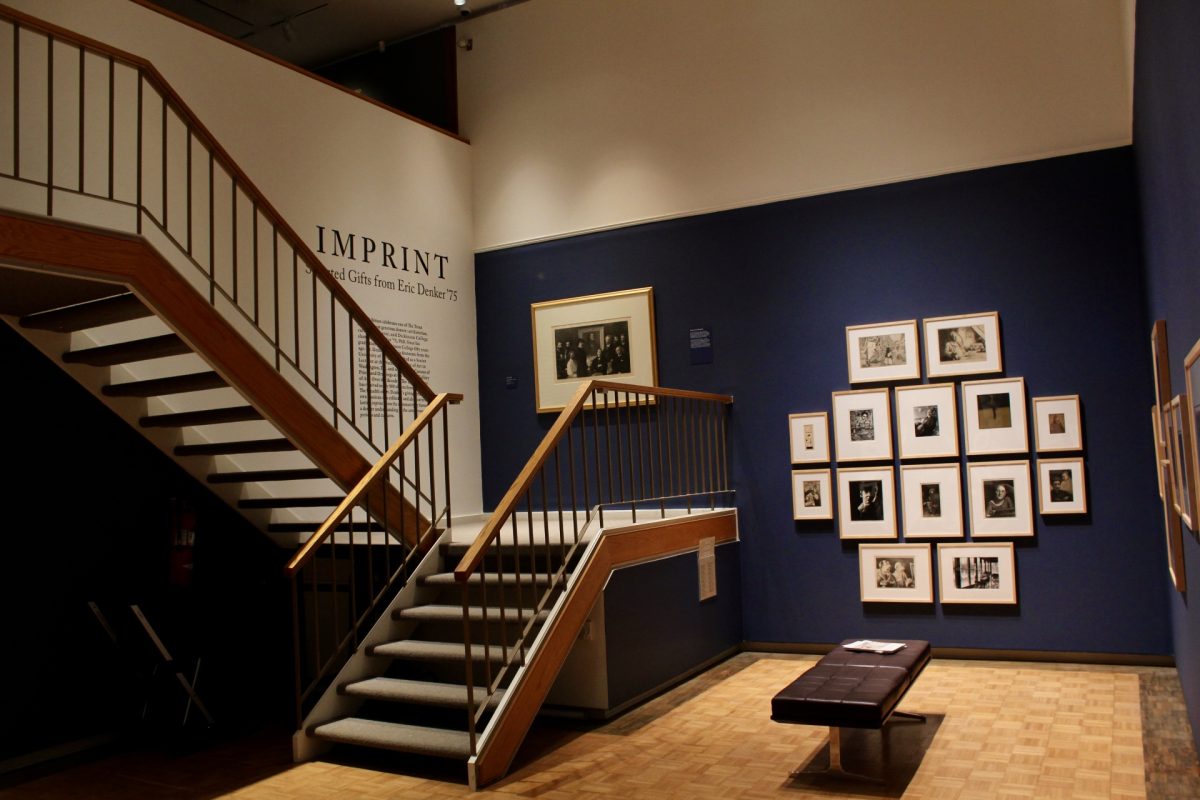On Tuesday, September 9, the Trout Gallery hosted a Lunch and Learn event with Dr. Eric Denker ’75, a retired curator and lecturer for the National Gallery of Art and long-time friend of the Trout Gallery. The event consisted of a brief introduction to Dr. Denker, a guided walkthrough of the Trout Gallery’s exhibition, “Imprint: Selected Gifts from Eric Denker,” and lunch with the art collector and curator. Dr. Denker made clear that, although the exhibit consisted solely of works that he had donated, he had not curated the collection on display. It was the work of the Trout Gallery’s faculty, staff and students, and Dr. Denker even complementarily mentioned that he would not have chosen to present the works this way. The works were chosen from the almost 900 pieces donated by Dr. Denker and arranged by subject: portrait, architecture, labor, and so on. The choices Dr. Denker has made over the years, of which pieces to collect (which he can bear to part with) has been framed, literally and figuratively, on the walls of the Trout Gallery.
Dr. Denker explained many of these patterns as he guided visitors through the gallery. He began his time at Dickinson as a political science major, but after a study abroad trip to Bologna, Italy, he realized his love of art history and returned to the college as an art history major. As Denker credits Italy with having sparked his career as a curator and educator, it was only appropriate that a large section of the gallery featured etchings of scenes from Italy.
Another wall is dedicated to portraits. In fact, it’s the first thing you see as you walk down the stairs to the gallery, with a photograph of Dr. Denker hung appropriately in the center of his collection. Portraits are not something Dr. Denker intentionally sought out in his collection, but they ended up becoming a large portion of what he donated to the Trout Gallery. Dr. Denker said that when deciding what pieces to collect, he considers the work’s community impact, its value for students, its appeal to him personally,and the artist’s interest. Portraits and self-portraits might meet these conditions uniquely well as a representation of the artist themselves, something that would be in their own self-interest to record and an invaluable piece of history for any student.
With motivations like these, Dr. Denker expanded the Trout Gallery’s collection of women artists, highlighting underappreciated names like Ellen Day Hale, Mabel Dwight and Peri Schwartz. His excitement at the prospect of their legacy being seen and appreciated by students was contagious. Peri Schwartz’s self-portrait is a monotype, a print made only once, and he told us how lucky he was to find such a piece from an artist like her for his collection. Dr. Denker told the story of meeting Ellen Day Hale’s niece and how many of the artist’s works were left in her studio, preserved by her family, and awaiting discovery by a wider audience. He helped the National Gallery of Art buy a large portion of her work, and happily collected a few pieces himself. A real and genuine care suffused the entire gallery as he told more stories like these with professionally tempered passion that seemed as though it could have only come through dozens of retellings over the course of his career.
Dr. Denker’s love for his work became clearer when he explained what pieces were not in the Trout Gallery’s collection. There were some pieces that Dr. Denker said he could not part with yet, emphasizing the final word. He is currently writing a biography on the artist Ernest David Roth, and Roth’s work has become too important and too personal to part with, for the time being. Dr. Denker described collecting solely for himself as “vanitas,” and, as such, it seems that there are very few works he intends to keep in his possession forever. He appears to be very focused on the next generation and sharing his love for these works to keep them to himself. He described giving one print to the Trout Gallery as painful, but in a good way, like a victory of his desire to share the piece over his personal attachment to it.
Why prints? They are, in fact, an almost perfectly appropriate manifestation of Dr. Denker’s goals. Prints are made by creating some sort of stamp, sometimes an etching, sometimes a carving, and that allows the work to be replicated, again and again, making them far more accessible than a unique piece of art. Dr. Denker described them as a “populist” form of art. Prints can be disseminated easily and viewed by more people. They’re also able to be sold at a much lower price point, allowing Dr. Denker to collect works by famous artists whose paintings sell for thousands of dollars. That allowed him to “live with” these works, as he put it, something he seemed to place a lot of value in. There must be something special that only an art collector knows, that comes from having a piece of art from an artist you’ve studied and admired in your home. Dr. Denker did not share where he keeps the Roth prints as he works on his biography, but the works must be close at hand, where they can be held and examined and studied at will. That must be entirely different from seeing a work in a gallery or online, and that must create an entirely different feeling in a scholar. It’s this feeling that Dr. Denker shares with Dickinson students with his donations to the Trout Gallery.
Dr. Denker called himself “an educator dressed as a scholar,” and that certainly rang true across the wall of the gallery, where all the choices he has made across his art collecting career are displayed. He collects art with future generations in mind, so that Dickinson students today can have the same transformative education that he had 50 years ago, but with a far greater array of artists represented. He ended the event with an invitation to finish exploring the exhibition, perhaps to find the inspiration embedded in every choice that created it.












Joe Massengill • Sep 18, 2025 at 2:39 pm
A very well written article.
Great job, Natalie. G. P. Joe
Judy Massengill • Sep 18, 2025 at 2:16 pm
Well written article providing the reader with great information.